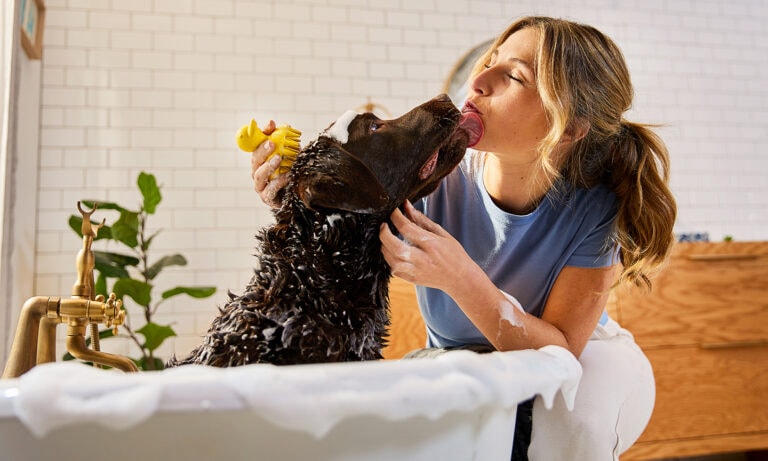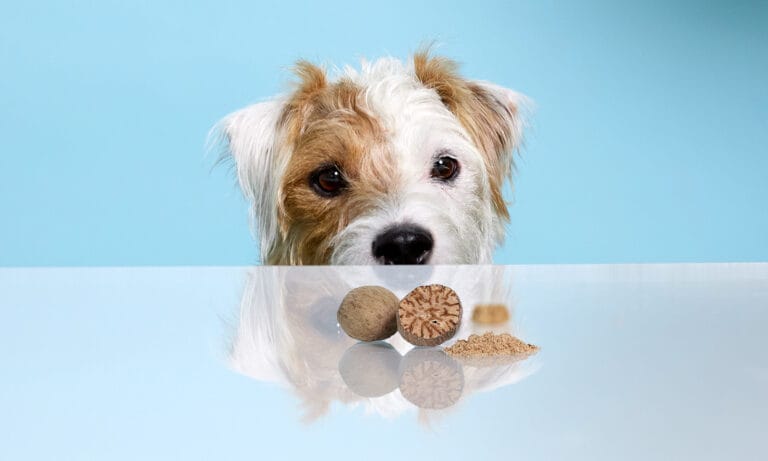Winter can be rough people and their pets—shorter days, freezing weather, fewer squirrels to chase. But it certainly doesn’t have to be that way. This year, consider a few easy changes to make the season a little bit easier for you and your pup.
Set up an Indoor Scavenger Hunt

Weather too dreadful to head outside? You can use indoor games to stimulate your dog both physically and mentally.
“Scavenger hunts can be arranged using the dog’s own food—dry dog food can be hidden in various places, whereas wet can be used in food toys, or small open containers as long as they’re not spilling all over the carpet,” says certified dog trainer and professional canine behavior consultant Joan Hunter Mayer.
You can also hide dog toys, dog treats and chews around the house.
“Make the game easier to begin with — hiding in plain site, then making it more challenging as the dog begins to understand the game and becomes more skilled at using his nose,” Hunter Mayer says.
Put Together a Winter First Aid Kit

While a dog first aid kit is good to have year round, integrative veterinarian Dr. Carol Osborne recommends adding a few winter-specific items to yours during the colder months. Make sure you have a thermometer, and ask your vet to demonstrate how to take your dog’s temperature.
“Cold weather can cause frostbite and sub-normal body temperature called hypothermia,” says Osborne.
Osborne also suggests adding a blanket to your kit to warm up a chilled or frostbitten pet, as well as cleaning solution like betadine or hydrogen peroxide in case your dog gets a cut from walking on salt.
“Always clean the wound with diluted betadine solution, or an anti-fungal/ anti-bacterial scrub,” Osborne says. “If the wound is deep, you need to take your dog to the vet for stitches, that is something that should not go unaddressed.”
Use Lights for Winter Visibility

Winter means less light in early mornings and evenings, and more unexpected dangers for your pup.
“Pets are extremely hard to see in the dark and, being so low to ground, can easily be missed by a biker or car headlights,” says Nicole Ellis, a dog trainer and dog panel expert at Rover.com.
To avoid accidents or even losing your pet, Ellis recommends putting a flashing light on your dog’s collar to add visibility and turn it on before sunset so you are prepared as the light quickly fades.
“Consider reflective or light-up bands for you and your pet’s legs or a light-up dog coat [that] can easily slip over your dog’s current outerwear,” says Ellis.
Make Your Own Paw Cream

Cold weather, salty streets and rough terrain can quickly damage a dog’s paws, so applying something to them regularly can help heal and moisturize them while preventing discomfort.
Liz Foley, a dog trainer and founder of The Dog Haus, recommends a mixture of coconut oil, bees wax and shea butter.
“Coconut oil is a great natural moisturizer for dogs’ paws that prevents cracked pads and also smells great, and bees wax and shea butter help to create a barrier that keeps moisture in and cold out,” says Foley. “These ingredients should be melted and combined together, then transferred to a tin and allowed to harden, making for easy application.”
Once ready, you can massage a little bit of the mix on each paw before a walk and then wipe the balm off after returning home. And if you don’t have natural bees wax on hand, it is often found in chapstick.
“This homemade remedy helps to protect paws from salt, cold and dryness,” Foley says.
Keep a Paw-Cleaning Station Near the Door

If roads and sidewalks are salted in the winter where you live, always remember to wipe your dog’s paws when you get back from a walk to prevent irritation.
“I always have a towel on hand for cleaning up paws after a winter walk,” says Kayla Fratt, a certified dog behavior consultant. “I’ve got a longhaired Border Collie, so I’m also sure to brush out his coat after it dries, otherwise, those icicles on his rump and tail turn into dreadlocks.”
Keep a towel, brush and a pack of wet towelettes near your entryway or front door to quickly get rid of mud, smells and other icky things before your dog comes into the house.
Pump Up Your Pup’s Workout

When you can’t spend a lot of time outdoors with your dog, try to make the most of the few minutes you do get to play outside.
“A nice game of fetch or Frisbee is great because the running back and forth will help tire them out,” says Ellis. “Or you can burn off energy and stay fit when it’s cold outside by using an automatic ball launcher.”
You can also use your time outside to practice obedience on your walk, Ellis says. Obedience training is mentally challenging for dogs so it makes for a great workout.
“Go from a heel to a stop, [then practice] heel while walking slow and fast and work on staying in tune to each other,” says Ellis.
Moisturize, Moisturize, Moisturize

Just as it does for us, winter can cause dry, flaky skin in dogs. While you can moisturize your dog’s skin, he can also benefit from an internal “moisturizer.”
Dr. William Morris, a veterinarian with Animal Medical Center, recommends omega-3 fatty acids as a great supplement for the skin.
“It’s important that the omega-3s come from a reputable company and the product is vet specific,” says Morris. “The omega-3 supplement for dogs has a slightly different formula than that for humans.”
Coconut oil is also a very popular treatment for dry skin, according to Morris.
“You can administer the oil orally (one teaspoon for small dogs and one tablespoon for larger dogs),” Morris says. “You can also apply coconut oil directly to the dog’s coat by rubbing it in with both hands.”
Winterize Your Pup’s Bed

Cold weather and less activity in winter often mean painful joints for senior dogs. To help them feel better, make a few adjustments to their beds by adding a few extra layers for warmth and comfort.
“Give your dog an old blanket: baby blankets, airline blankets or a cheap blanket from the drug store make great inexpensive options,” says Dr. Babette Gladstein. “Blankets provide more warmth than towels and your dog will curl up and keep warm in it.”
In addition, Gladstein says that using a memory foam pad is a great way to soften a bed for arthritic dogs.
“You don’t want to have them sleep on anything too soft because it’s harder for them to get up and out,” says Gladstein. “Memory foam provides the comfort they need but is sturdy enough to be easy on their joints.”
Use Indoor Time for Scent Games

Instead of taking a more professional scent training class, where dogs can learn to identify, follow and find certain scents, you can also do scent training right in your living room or backyard. Scent games (also known as nose work) is similar to a treasure hunt, but rather than randomly hiding treats around a room, you’ll work on one piece at a time as part of a training session.
Begin by putting your dog in a sit-stay position, show him a treat, then put it on the other side of the room. Once he finds it, make it harder to reach or hide it under something. Once your dog has learned to search for treats, you can do the same with toys (and reward him with a treat when he finds it) or other items.
“Scent work is one of my personal favorite ways to tire a dog,” says Ellis. “Once your dog understands scent work, you can quickly run through a few scent games before you head out the door and even make it a morning ritual together.”

Diana Bocco is a full-time writer and adventurer, whose work has been published in DiscoveryChannel.com, Yahoo!, & Popular Mechanics.
Share:









